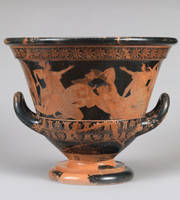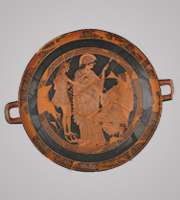|
|
 Red-figure calyx krater

Signed by the painter Euphronios, attributed to the potter Euxitheos Athens, c. 515–510 BC Clay H. 44.8 cm; Diam. 55 cm Provenance: Cerveteri (Italy) Campana collection, 1861 Department of Greek, Etruscan and Roman Antiquities. G 103 (Cp 748) Paris, Musée du Louvre © Photo DNP / Philippe Fuzeau This calyx krater, a masterpiece of Greek pottery, is signed by the painter Euphronios who was active in Athens in the late 6th century BC and is considered one of the most gifted artists of the period. He was one of a group of painters known as the "Pioneers", the first to use the red-figure technique. This krater, one of his most famous works, shows the hero Heracles slaying the giant Antaeus. The painter's bold, innovative style is reflected in the composition of the scene, the realism of the expression and the detailed rendering of the wrestling bodies. Euphronios excelled at mythological compositions, but also painted everyday scenes such as the music competition depicted on the other side of this krater. Red-figure cup

Signed by the potter Euphronios, attributed to the painter Onesimos Athens, c. 500–490 BC Clay H. 9.6 cm; W. 49 cm; Diam. 39.9 cm Provenance: Cerveteri (Italy) Acquired in 1871 Department of Greek, Etruscan and Roman Antiquities. G 104 (MNB 166) Paris, Musée du Louvre © Photo DNP / Philippe Fuzeau Around 500 BC, Euphronios set up a pottery workshop specializing in the production of cups. He himself worked there as a potter; this large ceremonial cup, signed Euphronios epoiesen ("Euphronios made it"), testifies to this change of activity. The painted decoration—which is attributed to one of his pupils, Onesimos—depicts the exploits of the hero Theseus, the son of Poseidon. The medallion shows Theseus with the goddesses Amphitrite and Athena; the outside of the cup is painted with scenes of the young hero's battles with bandits and wild animals, a pretext for Onesimos to portray figures in movement. Heracles Resting

Copy of a lost bronze original made by the sculptor Lysippos in the late 4th century BC Greece (?), 3rd century BC–1st century AD Bronze H. 42.5 cm Provenance: Foligno (Italy) Acquired in 1870 Department of Greek, Etruscan and Roman Antiquities, Br 652 Paris, Musée du Louvre © Photo DNP / Philippe Fuzeau This statuette is one of many copies of a bronze original made by the sculptor Lysippos around 330 BC. It represents the hero Heracles at the end of his twelve labours, leaning wearily on his club which is covered by the skin of the Nemean lion. His right hand originally held the apples of the Garden of the Hesperides, the fruit of his last labour. This representation of the resting hero contrasts with the usual images of Heracles in combat, such as the one on the krater of Euphronios. Lysippos also expresses a new artistic ambition: to situate the figure in three-dimensional space, thereby inviting the viewer to admire it from all sides for a full understanding of its meaning and its visual effects. Mask of Dionysos

Boeotia, c. 450–400 BC Clay H. 30 cm Provenance: Boeotia Acquired in 1895 Department of Greek, Etruscan and Roman Antiquities, CA 640 Paris, Musée du Louvre © Photo DNP / Philippe Fuzeau This terracotta mask represents Dionysos, the god of wine and theatre who presided over banquets at which men gathered to drink wine prepared in kraters. Dionysos was the son of Zeus and the mortal Semele, and his birth was a miraculous one: while Semele was pregnant, Zeus struck her with a thunderbolt and placed the unborn baby in his thigh. When Dionysos was born, he was entrusted to the old god Silenus; later, as a young man, he travelled widely in Asia before returning home where he struggled to be accepted as a god, inflicting madness on those who refused to worship him. Dionysos is therefore the god of the divine madness that finds expression in drinking and drama. This object is one of a series of masks of Dionysos that were made in Boeotia, a region in central Greece where his cult was very popular. Masks of this type were not intended to be worn. This one, originally richly decorated with colours that have not survived, could be suspended using the four holes in the diadem and beard. |
||